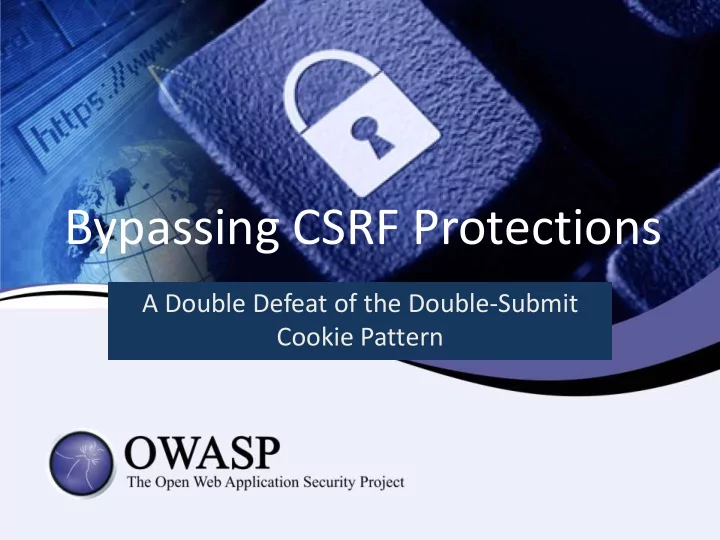

Bypassing CSRF Protections A Double Defeat of the Double-Submit Cookie Pattern
About Me • David Johansson (@securitybits) – Security consultant since 2007 – Helping clients design and build secure software – Security training – Based in London since 3 years, working for Cigital (now part of Synopsys)
CSRF Protection DOUBLE-SUBMIT COOKIE PATTERN
Cross-site Request Forgery • Attacker sends payload via victim’s browser • Browser automatically includes user’s identity
Double-submit Cookie Pattern • Simple CSRF protection – no server-side state
False Assumptions? Cookies are different! Not really true…
Cookie Fixation • What if attacker can set the CSRF cookie..? • Cookie fixation can be done through: – Exploiting subdomains – Man-in-the-middle HTTP connections
Double-submit Defeat #1: EXPLOITING SUBDOMAINS
Malicious Subdomain • Attacker controls https://evil.example.com/ • Subdomain sets cookie for parent domain • Includes specific path
Malicious Subdomain • Attacker now controls cookies sent to https://www.example.com/submit • Attacker’s CSRF cookie sent first due to longer path
Vulnerable Subdomain • Controlling all subdomains doesn’t mean you’re safe • XSS in any subdomain can be exploited: <script>document.cookie = “_ csrf=a; Path=/submit; domain=example.com”;</script> • So you’re using CSP? – Cookies can still be set through meta-tags ☺ <meta http-equiv="set-cookie" content="_csrf=a; Path=/submit; domain=example.com">
Double-submit Defeat #2: MAN-IN-THE-MIDDLE ATTACKS
Man-in-the-Middle Attacks • HTTP origins can set cookies for HTTPS origins • Even ‘secure’ cookies can be overwritten from HTTP responses* • Attacker who MiTM any HTTP connection from victim can: – Overwrite CSRF cookie – Pre-empt CSRF cookie *The new ‘Strict Secure Cookie’ specification will prevent this (https://www.chromestatus.com/feature/4506322921848832)
Overwrite CSRF Cookie
Pre-empt CSRF Cookie
Bypassing CSRF Protection • After fixating CSRF cookie, attacker can create successful CSRF payload
Mitigations • Additional defenses to strengthen double- submit cookie pattern: – HTTP Strict Transport Security (HSTS) – Cookie Prefixes (“__Host - ” is the one you want) – Sign cookie – Bind cookie to user – Use custom HTTP header to send request token
This is not the token you’re looking for… ANGULAR & CSURF
AngularJS CSRF Protection • AngularJS $http service has built-in support to help prevent CSRF* • Reads token from cookie (XSRF-TOKEN) and sets custom HTTP header (X-XSRF-TOKEN) • Server needs to implement token validation • Can be used as double-submit cookie pattern if server compares cookie value with HTTP header *https://blogs.synopsys.com/software-integrity/2017/02/24/angularjs-security-http-service/
AngularJS & csurf
Default Value Function Body and query parameters checked first!
Exploit Default Value Function = CSRF Defense Bypassed
Specify Custom Value Function
Summary • Double-submit Cookie Pattern based on partially incorrect assumptions • Integrity protection of cookies is very weak • Attackers can often force cookies upon other users • Be careful which token you validate against • Additional mitigations often required to strengthen the defense
Thank You! Questions? @securitybits
Recommend
More recommend